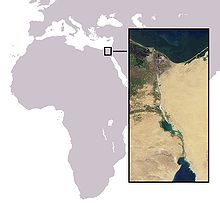User:Ayub Shahada/Port of Gaza

Port of Gaza[edit]
The Port of Gaza is a small port near the Rimal district of Gaza City and it is the home port of Palestinian fishing boats.[1] Located on the east coast of the Mediterranean and has a water area of 48,000 square meters and 970 meters deep[1]. Fishing is restricted to 6 nautical miles from the coast, under the Oslo Agreement from 2012, and it generates over 100,000 jobs.[2] This port is considered in the future to be rebuilt to make Gaza economically independent.[1]
History[edit]
Gaza Strip[edit]

The Gaza strip suffers from strict siege, by land, air, and sea.[3] The total surface area of 362 square kilometers,[4] owns a main transportation system that only has 76km of main roads.[3] The strip had a small airport located at Rafah built by the Palestinian National Authority which was destroyed in 2001 by the Israeli forces.[3]
Since 1994[edit]
In 2002, Israeli forces attacked the Palestinian Naval Police facilities in the port, after Naval Police commanders were implicated in the Karine A affair, an attempt to secretly bring in 50 tons of weapons by boat into Gaza.
In 2007, following Hamas' takeover of Gaza, Israel imposed a blockade of the Gaza Strip, including a naval blockade.[5] Several attempts to break the Israeli blockade have been made. Israel has prevented most ships from docking at the Port of Gaza, but did allow two boats, carrying activists and some supplies, to reach the port in 2008. As of 2010, the port was restricted to smaller Palestinian fishing boats.
In 2010, the port was deepened by Hamas in preparation for the arrival of a blockade-breaking flotilla of larger international ships. A breakwater was constructed and lighting was installed. Hamas announced plans to develop the port to make it more accessible to fishermen and attract tourists.[2]

Since 2007[edit]
Gaza port has only been used by fishermen on a small scale due to the sea blockade imposed by Israel, as part of the blockade imposed on the Gaza Strip, that restricted trade and movement of people.[6] Israel justifies that this blockade was required to stop Hamas activities.[6] However, this affected the lives of ordinary citizens in the Strip and destroyed civil rights and other social services.[6] Since then, a humanitarian crisis emerged and the Gaza strip became a place where 1.8 million people are trapped. [6]
Ancient History[edit]
This port is believed that had an important rol during the Imperial Roman period.[7] In 2011, eight columns from the times of Emperor Constantine were found in the port.[7] The port at the time was named by the Emperor as Mayomas, meaning harbor place.[7]The port was one of the important roads that served as a dispatch of products that came from Saudi Arabia markets to the European Nations.[7] At that time Camels were used as a form of transportation to deliver the products through Saudi Arabia, Petra until arrived in the Port of Gaza.[7]
Seaport Fishing[edit]


Gaza strip has 45km of coastland that connects with the Mediterranean Sea and the Suez Canal.[8][9]The waters of the Suez Canal makes Gaza a great location for the arrival of new and rare species of fish every year.[9] Since 2018, Gaza holds the record for the first catch of the species known as Acanthurus Sohal.[9] This species lives in the Indian Ocean and is very rare to see on the Mediterranean Sea.[9] Gaza each year catches over 1800 tonnes of fish that are mainly composed of Sardines and Tuna.[8]
Seaport plans[edit]
Since the 1993 Oslo I Accord, there have been plans to build a much larger seaport in Gaza. Due to the continuing Israeli–Palestinian conflict, these plans have not materialized as of 2014.[1]
In 2005, Israel approved Palestinian plans to rebuild and complete the construction of a port a few miles south of Gaza City, which had begun before the outbreak of the Second Intifada in September 2000.[1]The building was destroyed by Israeli forces together with Gaza's existing airport near Rafah following the outbreak of the Second Intifada. [1]
References[edit]
- ^ a b c d e f "Seaport of Gaza". www.alaqsa.edu.ps. Retrieved 2020-11-13.
- ^ a b "In Gaza, the transformation of fisheries can bring jobs and improve livelihoods". blogs.worldbank.org. Retrieved 2020-10-30.
- ^ a b c Sarraj, Yahya R. (2018-11-14). "Hourly and Daily Traffic Expansion Factors on Selected Roads in Gaza, Palestine". The Open Civil Engineering Journal. 12 (1): 355–367. doi:10.2174/1874149501812010355. ISSN 1874-1495.
- ^ "Recent Economic Developments, Prospects, and Progress in Institution Building in the West Bank and Gaza Strip". 1997-02-28. doi:10.5089/9781557756381.071.
{{cite journal}}: Cite journal requires|journal=(help) - ^ Ashar, Asaf (2019). "GAZA PORTS ALTERNATIVES" (PDF). Gaza Seaport Group of Experts.
{{cite web}}: CS1 maint: url-status (link) - ^ a b c d Butt, Khalid (2016). "Blockade on Gaza Strip: A Living Hell on Earth". Journal of Political Studies. Vol.23: 157:182.
{{cite journal}}:|volume=has extra text (help) - ^ a b c d e "Seaport of Gaza". www.alaqsa.edu.ps. Retrieved 2020-11-14.
- ^ a b Elhaweet, Alaa (2004). "ASSESSMENT OF PURSE SEINE FISHERY AND SARDINE CATCH OF GAZA STRIP" (PDF). EGYPTIAN JOURNAL OF AQUATIC RESEARCH. VOL. 30 (B): 306–321.
{{cite journal}}:|volume=has extra text (help) - ^ a b c d Bariche, Michel (2019). "Records of two non-indigenous fish species Synanceia verrucosa Bloch and Schneider, 1801 and Acanthurus sohal (Forsskål, 1775) from the Gaza strip (eastern Mediterranean Sea)" (PDF). BioInvasions Records. VOL 8: 699–705.
{{cite journal}}:|volume=has extra text (help)
